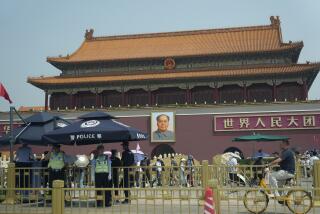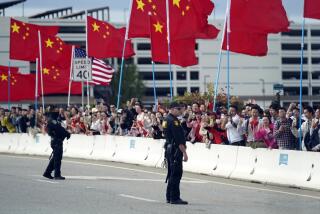First Hong Kong protested. Now it’s Wuhan, China. What makes it Beijing’s latest headache?
Reporting from Beijing — On suffocating summer nights in Wuhan city, China, the smell of burning garbage drifts through the air, so acrid that people close their windows and complain they cannot get to sleep. And when local authorities recently tried to rush through a waste-to-energy plant to incinerate garbage, they provoked days of furious protests, in a nation where authorities are swift to crush dissent.
Protesters stayed on the streets for days, according to social media.
Wuhan’s protests unfolded as unrelated demonstrations in Hong Kong shook Beijing authorities and images of Hong Kong riot police pepper-spraying young protesters gripped the world.
But both protests tell a story of the problems Chinese authorities face — containing discontent on the mainland over hot-button issues like environmental desecration, scandals over food or medical standards and rising prices, while facing a new generation of Hong Kong protesters who feel alienated from China and its increasingly heavy-handed authoritarian model.
News of the protest in Wuhan in Hubei province trickled out on Chinese social media, but was largely censored once the story gained some traction as local authorities failed to gain immediate control of the march.
It also underscores the often clumsy approach of local authorities in China, rushing to implement projects with scant regard for transparency or popular concern.
One video of the protests showed a small boy, perched on the front of a pink motor-scooter driven by a woman who may have been his mother. He was also seen standing in front of a huge protest banner wearing shorts and a fluorescent green vest, with a large orange plastic whistle around his neck, holding up a blue megaphone and chanting protest slogans, while the crowd followed his lead.
“Give me back green mountains and blue water!” he chanted, using the environmental slogan that united the protesters. “Ban garbage burning!” he said. “Waste-to-energy plant get out!”
In the early stages of the protest, before censors kicked in, this and other posts were popular online and the issue grew to be one of the “hot topics” on Weibo, the Chinese equivalent of Twitter. Censors then stepped in, removing most of the posts about the incident.
But some Chinese netizens circulated videos on sites out of Chinese censors’ reach, including Twitter and Facebook, using virtual private networks. Few mainland Chinese can access such sites because VPNs are illegal in the country.
Many people online feared the planned waste-to-energy plant in Wuhan’s Yangluo subdistrict would make things worse, and would not reduce the smell or adhere to strict environmental standards.
“A lot of people live close to the landfill in Yangluo. You can smell it every night in that area. People kept on complaining and the government promised it would be turned into a park in a few years,” wrote one user with the handle Ju Zi Ju Ne on June 30. “Now it is being turned into a waste-to-energy plant without any announcement. What is going on? Just blindly ignoring people and children’s health.”
Video showed large crowds, at some points in the thousands, on the streets of Wuhan in daylight and in darkness. Many of them wore yellow T-shirts. They carried a large white banner with black characters, marched and blocked streets.
The protest appears to have gotten out of hand June 28, when riot police confronted crowds — beating some with batons, wrestling others to the ground and dragging others away, according to video purporting to portray the event and accounts by social media users.
“People’s hearts are bleeding watching their fellows being dragged away one by one,” one posted. Video showed protesters pelting riot police with plastic bottles and shouting angrily.
One photograph that was being circulated showed a man lying in an ambulance with his head bleeding. Another showed police wrestling an elderly woman to the ground and kneeling on her neck. Others showed protesters with bleeding heads. It was not possible to verify whether all — or none — were linked to the Wuhan protest.
What does seem clear from social media posts with the hashtag #WuhanYangluoWasteBurning is that the protest did continue for at least several days — even after the government in Xinzhou district, which encompasses Yangluo, posted a June 28 message on its official social media account promising not to proceed with the waste-to-energy plant unless the population agreed.
“Recently the Chenjiachong waste-to-energy plant project in Yangluo, Xinzhou district, aroused great concern in the society,” the district government posted. “The Xinzhou district government attaches great importance to the voice of the people and promises to the people that the project will not commence if the masses do not agree.”
The protests also indicated the depth of anger about environmental problems that directly affect people’s quality of life, after decades in which Chinese authorities sacrificed the nation’s environment, air, soil and water for the sake of breakneck economic growth.
Wuhan’s protest comes at the worst possible time for Chinese authorities, in a year in which there are several sensitive dates, including the recent 30th anniversary of the Tiananmen Square massacre of pro-democracy protesters and the 70th anniversary of the founding of the People’s Republic of China on Oct. 1.
On top of that, Hong Kong protests have put Beijing under pressure by energizing a new young protest generation in the semiautonomous territory. The Hong Kong protests and the heavy-handed police approach have tarnished China’s crucial “one country, two systems” model, which is supposed to provide the template for Taiwan’s reunification with the mainland.
Then there are other challenges: the country’s economic slowdown, a mounting debt problem, the economic and business pressures caused by the trade war with the United States, and growing criticisms from Western nations over China’s industrial policies and its reeducation camps in the western region of Xinjiang, where around a million ethnic minority Muslims are interned.
China supports Hong Kong’s pro-Beijing leader Carrie Lam and has accused Western nations including the U.S. and Britain of interfering and stirring up trouble in Hong Kong. Beijing has characterized the Hong Kong protests as “totally intolerable” riots, and called on authorities there to arrest and prosecute demonstrators it calls “violent” offenders.
Small-scale protests in China over issues such as the environment, food or medicine safety scandals or military pensions occur from time to time, but authorities are careful to make sure they are crushed before they can gain traction.
But according to people claiming to be Wuhan residents and posting on social media, the protests lasted many days. Video portrayed thousands of people on the streets. They also claimed that people were injured in clashes with police, although no estimates were posted. The claims cannot be independently verified.
“Today is the seventh day that we, the people of Yangluo, defended our rights,” one person with the handle Xiaolan0003 wrote Thursday on social media, saying that posts on the news had been blocked by censors. “The government is trying its best to downplay the importance of this issue, and the ordinary people who were injured. We would just like to have a clean environment. We would like to breathe clean air. Why is it so difficult?”
“No one came out to explain things clearly to the people during the past week. There was only cold repression and force,” wrote a social media user with the handle Dong Fang Qiu Huo, adding that older people had worked hard to buy decent houses in Yangluo, “but everything is smashed in the cloud of waste-to-energy plants.”
Some complained about the lack of transparency in the decision to build the plant and expressed fears that the operating company would sacrifice the interests of the people for the sake of profit.
One user claiming to be from a Wuhan neighborhood near a similar plant complained that “it stinks every night when it processes the garbage. One cannot afford to open the window at night in summer.”
Many complained that they could accept the plant if it was moved farther from apartments, homes, schools and colleges.
“Go, Yangluo people,” one person posted. “If we don’t stand up, we’ll be buried.”
More to Read
Sign up for Essential California
The most important California stories and recommendations in your inbox every morning.
You may occasionally receive promotional content from the Los Angeles Times.










